Martienssen W., Warlimont H. (Eds.). Handbook of Condensed Matter and Materials Data
Подождите немного. Документ загружается.


792 Part 4 Functional Materials
Table 4.3-31 Nonferromagnetic Mn-based elinvar-type alloys. Composition, thermal expansion coefficient α, Young’s modulus E
and shear modulus G, and their respective temperature coefficients, e and g and hardness HV [3.17]
Composition in wt% α
a
E e
a
G g
a
HV
Mn
Cu Ni Cr Fe Co Mo W Ge (10
−6
K
−1
) (10
10
Pa) (10
−5
K
−1
) (10
10
Pa) (10
−5
K
−1
)
87 10 3 23.7 12.3 1.25 5.18 1.05 121
82 15 3 23.0 12.1 0.55 5.07 0.78 149
80 16 4 21.1 12.2 −0.13 4.63 −0.75 150
80 9 11 20.3 11.9 0.05 5.00 1.10 380
80 20 12.3 9.0 1.5 255
79 21 9.8 −2.5 3.60 −2.7 235
67 20 13 22.4 14.4 0.21 4.55 0.29 125
59 16 25 21.6 16.2 0.85 5.21 0.83 250
49 41 10 22.4 13.5 −0.97 5.53 −0.20 250
44 55 1 22.1 13.2 0.11 5.03 0.08 145
43 57 23.6 11.2 0.3 4.2 −0.9 131
43 55 2 22.9 8.50 −1.11 4.02 −2.57 135
42 55 3 23.0 15.2 2.30 6.77 1.88 149
39 56 5 23.2 12.0 −0.25 5.05 −0.56 140
a
For the temperature range 0–40
◦
C
b
At 20
◦
C
Table 4.3-32 Properties of an antiferromagnetic Fe
−
24Mn
−
8Cr
−
7Ni
−
0.8Be elinvar alloy [3.53]
Property Value
Young’s modulus E 165–195 GPa
Thermoelastic coefficient TKE (1–10)MK
−1
Compensation range of E 0–50
◦
C
Shear modulus G 74–82 GPa
Coefficient of thermal expansion α (20–100
◦
C) 13 MK
−1
Tensile strength σ
B
1200–1800 MPa
Yield point σ
s
1100–1650 MPa
Elongation δ 12–2 %
Vicker’s Hardness HV 10 420–540 HV
Quality factor Q 20 000–10 000
Specific electrical resistance ρ 80 µΩ cm
Density γ 7.6gcm
−3
Electrochemical breahdown potential
D
−0.25 V
Melting temperature T
s
1450–1480
◦
C
antiferromagnetic elinvar alloy was developed which
fulfills the complex requirements for an antiferromag-
netic, corrosion resistant, temperature compensating
thermoelastic spring material for applications near
room temperature, Fig. 4.3-51 [3.53]. The thermoelas-
tic, mechanical and physical properties are summarized
in Table 4.3-32 [3.53].
Other Nonmagnetic Elinvar-Type Alloys. In general,
the elastic constants decrease with increasing tem-
Part 4 3.2
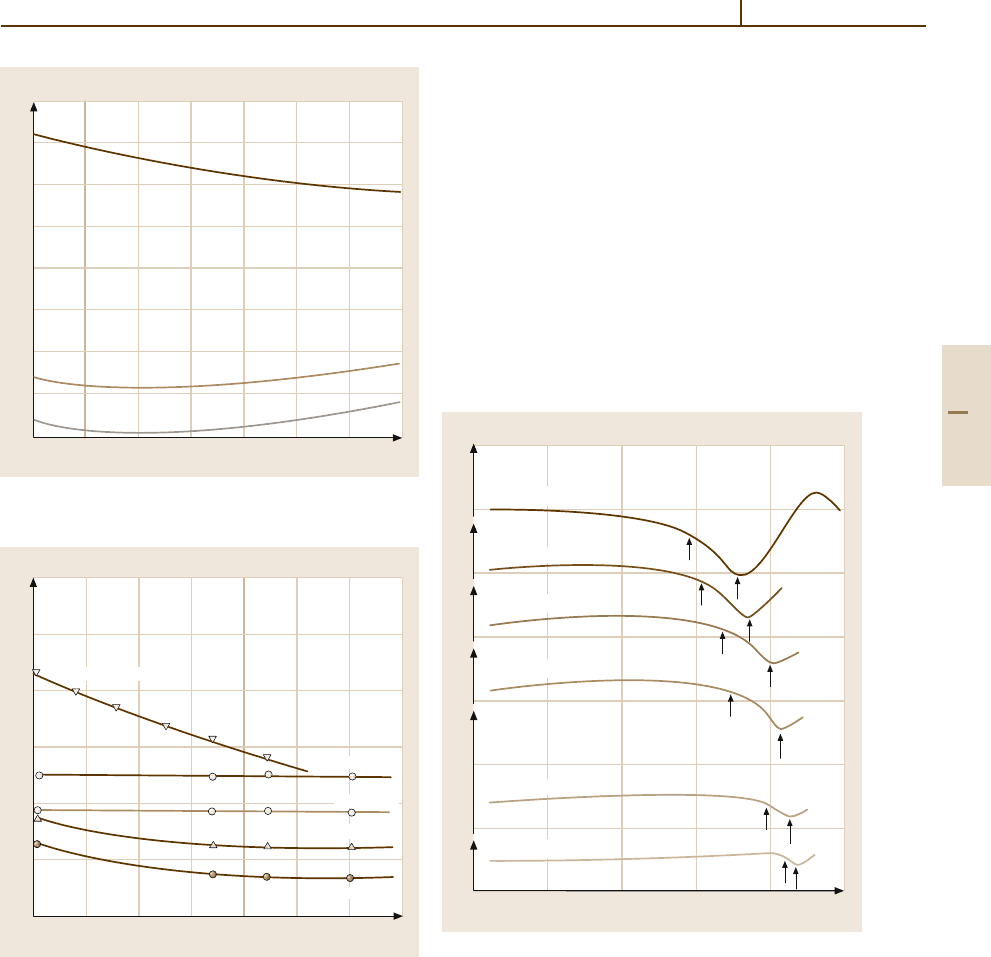
Magnetic Materials 3.2 Soft Magnetic Alloys 793
16
15
14
13
12
11
10
9
8
–100 0 100 200 300 400 500 600
(× 10
3
)Young’s modulus E (kp/mm
2
)
T(°C)
(100)
(110)
(111)
Fig. 4.3-52 Thermoelastic behavior of single crystalline
Nb in the major lattice directions [3.54]
15
14
13
12
11
10
9
–200 –150 –100 –50 0 50 100 150
E (× 10
10
Pa )
T(°C)
Nb–10 wt% W
10 wt% V
2 wt% Zr
10 wt% Ta
Pure Nb
Fig. 4.3-53 Young’s modulus E vs. temperature. Samples
annealed at 1400
◦
C for 4 h [3.41] of pure Nb and Nb-based
binary alloys
perature. The temperature dependence of the elastic
properties of Nb shows highly anisotropic anoma-
lies (see Fig. 4.3-52) [3.54]. In a randomly oriented
polycrystal, Nb becomes an elinvar-type material,
Fig. 4.3-53 [3.41]. This plot of Young’s modulus vs.
temperature also shows the influence of alloying elem-
ents.
Elinvar behavior is, also, found in concentrated
Nb
−
Zr and Nb
−
Ti alloys. Furthermore, some amor-
phous alloys, e.g., in the Fe
−
B-, Fe
−
P-, and
Fe
−
Si
−
B-based systems, show elinvar behavior. Ex-
amples for amorphous Fe
−
B alloys are shown in
Fig. 4.3-54.
14
13
13
13
13
14
13
13
0 100 200 300 400 500
T(°C)
E (× 10
10
Pa)
Fe
86
B
14
Fe
85
B
15
Fe
83
B
17
Fe
82
B
18
Fe
80
B
20
Fe
79
B
21
T
c
T
x
Fig. 4.3-54 Fe
−
B alloys. Temperature dependence of
Young’s modulus E for amorphous alloys annealed at
200
◦
Cfor2h.T
x
and T
c
show the crystallization and the
Curie temperature, respectively [3.41]
Part 4 3.2
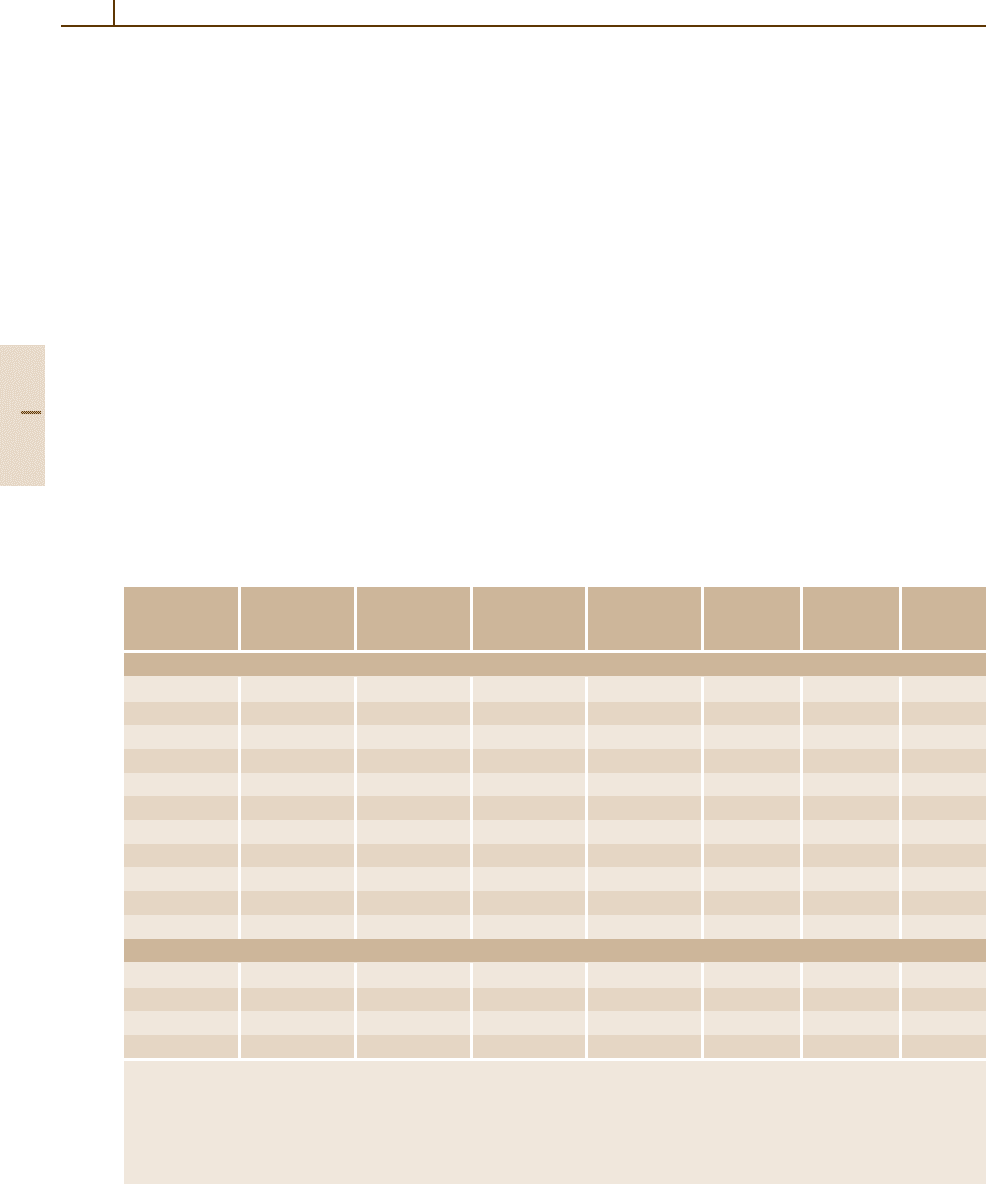
794 Part 4 Functional Materials
4.3.3 Hard Magnetic Alloys
Permanent or hard magnetic materials comprise tra-
ditionally some special steels but consist essentially
of multiphase alloys and intermetallic and ceramic
compounds today. Relatively few magnetic alloys
and compounds fulfill the requirement of combin-
ing high magnetic efficiency and competitive cost:
Fe
−
Ni
−
Al
−
Co (Alnico), Fe
−
Cr
−
Co, Mn
−
Al
−
C,
hard ferrites, and rare-earth transition metal compounds
of the Co
−
Sm, Fe
−
Nd
−
BandFe
−
Sm
−
N alloy sys-
tems. Surveys may be found in handbooks [3.1, 3, 55]
and data collections [3.10, 56]. A survey of permanent
magnetic materials is given in Table 4.3-33. The metal-
lic hard magnets are treated in this chapter, the oxidic
hard magnetic materials are dealt with in Sect. 4.3.4.
All of the hard magnetic materials are based on
choosing a base alloy with a sufficiently high satura-
tion magnetization M
s
and a high magnetocrystalline
anisotropy constant K
1
, and tailoring the microstructure
to exploit this crystal anisotropy. In some cases, shape
Table 4.3-33 Survey commercially used permanent magnetic materials. Survey
Material Fe, Co content B
a
r
J
H
c
(BH)
max
appr. T
c
T
b
max
Process
c
(wt%) (T) (kA m
−1
) (kJ m
−3
) (
◦
C) (
◦
C)
Dense magnets
3.5Cr steel 94–95 0.95 5 2.3 745 C
d
6W steel 92–93 0.95 6 2.6 760 C
36Co steel 90–91 0.95 19 7.4 890 C
Alnico 67–74 0.52–1.4 40–135 13–69 810–900 450–550 C, P
d
Fe
−
Cr
−
Co 65–73 1.1–1.4 40–65 25–55 670 500 C
hard ferrite 58–63 0.37–0.45 160–400 26–40 460 250 P
Pt-Co 23.3 0.64 430 73 480 350 C, P
MnAlC – 0.55 250 44 500 300 P
Co
5
Sm 63–65 0.85–1 >1600 140–200 730 250 P
TM
17
Sm
2
61–68 0.95–1.15 480–2000 190–220 810 330–550 P
Fe
−
Nd
−
B 66–72 1.05–1.5 950–2700 240–400 320 60–180 P
Bonded magnets
hard ferrite 58–63 0.1–0.31 180–300 2–18 140 P
TM
17
Sm
2
61–68 70–120 150 P
Fe
14
Nd
2
B 70–72 0.47–0.69 600–1200 35–80 80–110 P
Fe
17
Sm
2
N
3
0.77 650 105 100 P
a
B
r
values are for magnets operated at load lines B/H 1
b
The maximum operating temperature of bonded magnets is determined by the organic binder used
c
Magnets are manufactured either by a casting/heat treatment technique or by a powder metallurgical process. Powder metallurgy is
applied for small magnets where small and intricate shapes to precise tolerances are required
d
C: magnets produced by cast and heat treatment; P: magnets produced by means of powder metallurgical techniques
anisotropy is generated in addition. This microstructural
control is achieved by
1. Inducing a texture by processing in such a way that
a macroscopic direction in the material, e.g., the
rolling direction of a sheet or the pressing direc-
tion in a sintered material, is an easy direction, and
processing at 90
◦
, i. e., the transverse direction, is
a hard direction for magnetization. This is the basic
magnetic hardening mechanism of hard magnetic
steels which have lost their importance in present
technology; but it is the basis of producing the more
recent high energy magnets made from intermetallic
compounds such as Co
5
Sm and ferrites.
2. Inducing a two-phase microstructure by coherent
precipitation or decomposition and promoting, by
suitable magnetic field annealing procedures, the
alignment of the elongated precipitates in one di-
rection of easy magnetization, i. e., inducing both
Part 4 3.3
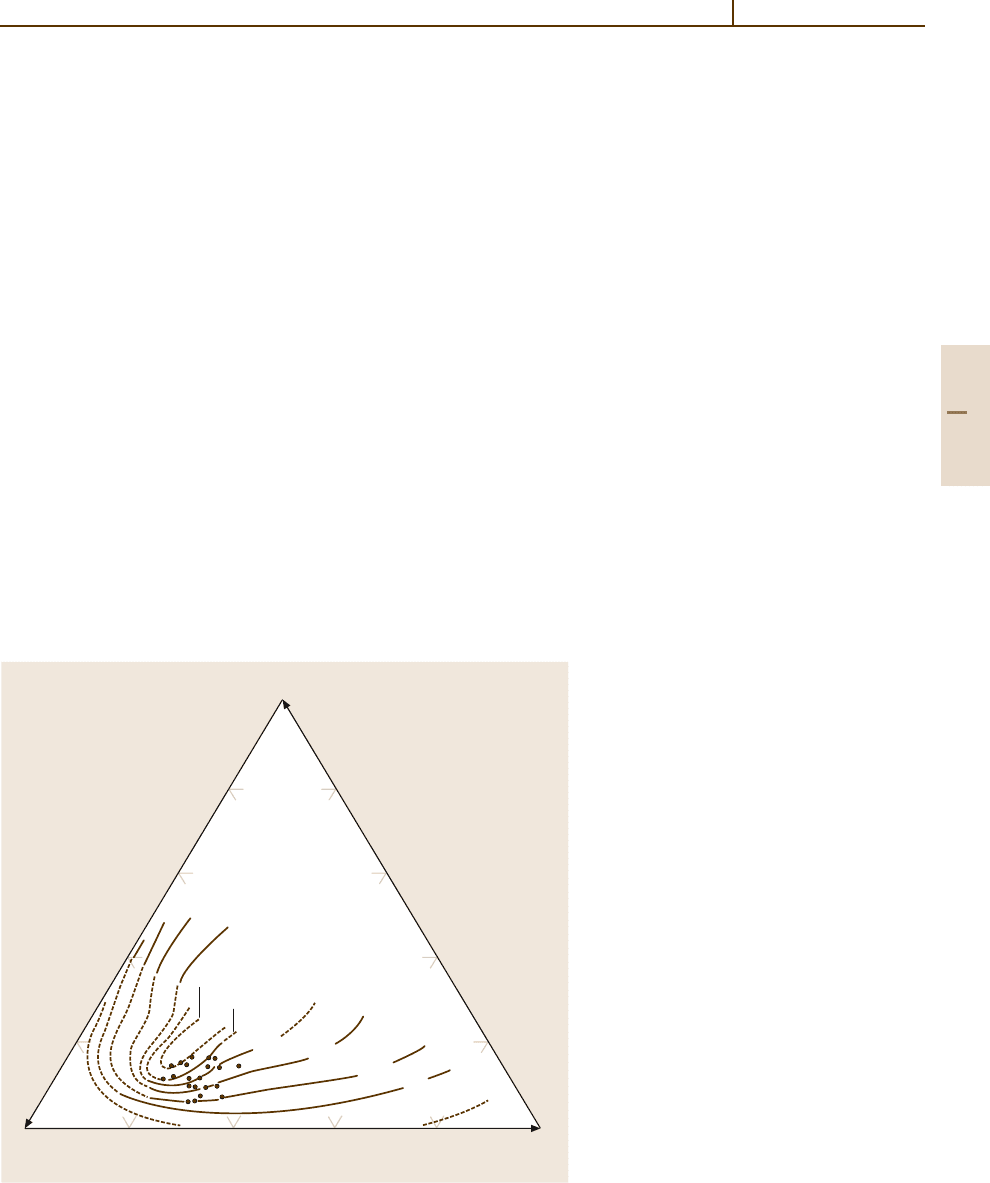
Magnetic Materials 3.3 Hard Magnetic Alloys 795
magnetocrystalline and shape anisotropy. This is
termed magnetic shape anisotropy and is employed
in the Alnico and Fe
−
Co
−
Cr hard magnetic mater-
ials.
3. Inducing a fine grained microstructure with a mag-
netically insulating phase at the grain boundaries
so that the grains are magnetically decoupled and,
as a consequence, the nucleation of reverse magne-
tization is requiring an extremely high nucleation
energy. This is applied, for example, to TM
17
Sm
2
,
Fe
14
Nd
2
B and bonded magnets.
In some of the hard magnetic materials two of these
variants of microstructural design are combined.
4.3.3.1 Fe–Co–Cr
Hard magnetic materials made of ternary Fe
−
Co
−
Cr
alloys are based on the high atomic moment of Fe
−
Co
alloys and the miscibility gap occurring when Cr
is added. Intrinsic magnetic properties are compiled
in [3.6]. Extensive magnetic materials data are found
in [3.56]. Figure 4.3-55 shows the relevant metastable
phase relations in the ternary equilibrium diagram. If an
alloy is homogenized in the solid solution range above
20 40 60 80 Cr
Co
xFe–yCr–z Co
20
80
6040
60
40
20
80
y (wt%) Cr
Fe
x (wt%) Fe z (wt%) Co
560°C
=700°C
680°C
660°C
640°C
620°C
600°C
T
m
α
1
α
2
α
1
α
2
+
Fig. 4.3-55 The miscibility gap
(α
1
+α
2
) of the bcc α-phase in the
Fe
−
Co
−
Cr phase diagram [3.56]
the solvus surface with T
max
> 700
◦
C first and annealed
in the miscibility gapsubsequently, coherent decomposi-
tion occurs, which results in a two-phase microstructure
on the nanometer scale. The α
1
phase is rich in Fe and
Co and ferromagnetic while the α
2
phase is rich in Cr
and antiferromagnetic. This two-phase microstructure
on the nm scale has hard magnetic properties which
can be varied by adjusting the alloy composition and
heat treatment. The term spinodal decomposition is
frequently applied to all kinds of coherent decompo-
sition, e.g., in [3.56]. But it is used correctly only if
referring to a special mode of compositional evolution
associated with particular kinetics in the initial stage
of decomposition within the spinodal of a miscibility
gap.
Three groups of materials have been developed,
differing essentially in the Co content (< 5, 10–15, 23–
25 wt% Co), while the Cr content ranges from 22 to
40 wt% Cr. Table 4.3-34 lists data obtained by vary-
ing composition, mode of manufacturing, and heat
treatment systematically for the group characterized
by < 5 wt% Co as an example. The variation of the
magnetic properties is determined by the intrinsic prop-
erties of the decomposed phases α
1
and α
2
and their
microstructural array.
Part 4 3.3
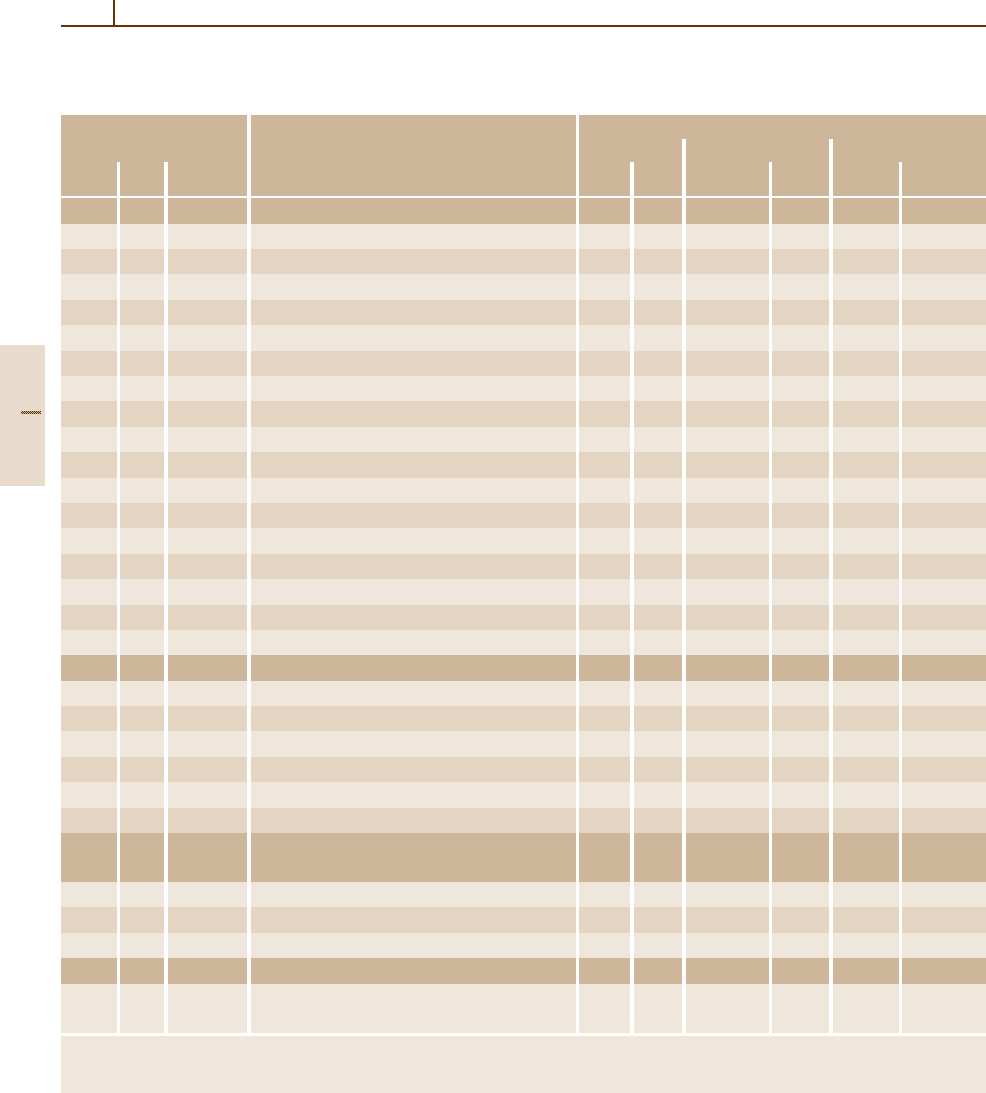
796 Part 4 Functional Materials
Table 4.3-34 Survey of magnetic properties of Fe
−
Cr
−
Co (≤ 5 wt% Co) alloys in relation to the composition, mode of
manufacturing and heat treatment [3.56]
Alloy components (wt%) Mode of manufacturing and heat treatment Magnetic properties
B
r B
H
c
(BH)
max
Cr Co others (T) (kG) (kA m
−1
) (kOe) kJ m
−3
(MGOe)
33 2 1Hf H(700, 15):MCL > T
s
, R, 500):FCL 1.25 12.5 16.2 0.203 14.0 1.76
32 3 As above 1.29 12.9 35.9 0.449 32.4 4.08
32 4 0.5 Ti As above 1.26 12.6 42.7 0.534 40.1 5.06
28 5 As above 1.38 13.8 29.0 0.362 27.9 3.52
30 5 As above 1.34 13.4 42.2 0.528 42.1 5.31
33 5 As above 1.22 12.2 40.8 0.51 36.3 4.58
35 5 As above 1.15 11.5 37.0 0.462 29.3 3.69
30 5 0.1 B As above 1.31 13.1 42.0 0.525 40.2 5.07
30 5 0.25 B As above 1.29 12.9 39.8 0.498 34.8 4.39
30 5 0.1 C As above 1.31 13.1 42.2 0.527 38.8 4.89
30 5 0.8 Ge As above 1.32 13.2 24.8 0.31 39.1 4.93
30 5 0.25 Ti As above 1.34 13.4 27.2 0.34 40.2 5.07
30 5 0.5 Ti As above 1.30 13.0 41.4 0.518 40.1 5.06
30 5 1.5 Ti As above 1.27 12.7 40.8 0.51 38.1 4.81
30 5 0.25 Hf As above 1.32 13.2 43.0 0.537 41.2 5.2
30 5 0.5 Hf As above 1.29 12.9 43.9 0.549 41.4 5.22
30 5 1Hf As above 1.30 13.0 43.0 0.537 40.4 5.1
30 5 3Hf As above 1.24 12.4 41.5 0.519 34.8 4.39
23 2 1Hf MCL(> T
s
, 550): CCL (550, 500) 1.24 12.4 36.8 0.46 34.1 4.3
32 3 As above 1.25 12.5 40.0 0.5 34.1 4.3
30 5 As above 1.34 13.4 42.4 0.53 42.0 5.3
32 4 0.5 Ti As above 1.26 12.6 42.8 0.535 40.4 5.1
28 5 4Ni As above 1.27 12.7 29.6 0.37 30.1 3.8
28 7 As above 1.25 12.5 40.8 0.51 41.2 5.2
27 9 MCL: CCL (as above) 1.30 13.0 46.4 0.58 49.2 6.2
33 5 CL(680, 40 K/h):HW(D:67%):H (600): 1.15 11.5 24.8 0.31 19.0 2.4
CCL (15–4 K/h, 500)
a
33 7 2Cu As above 1.19 11.9 38.8 0.485 26.2 3.3
33 7 As above 1.18 11.8 42.0 0.525 33.3 4.2
33 9 As above 1.24 12.4 46.4 0.58 32.5 4.1
28 7 CL(> T
s
,60(T
s
= 645
◦
C)) 0.97 9.7 26.4 0.33 11.1 1.4
31 5 (Sintered 1400
◦
C, 4 h; H
2
)
b
:WQ: H (700, 30): 1.23 12.3 40.0 0.5 34.9 4.4
FCL (700, 640):MCL (640, 0.9K/h, 500)
a
For the deformation aging process the initially aged state corresponds to an overaged state
b
Sintering ST
Part 4 3.3
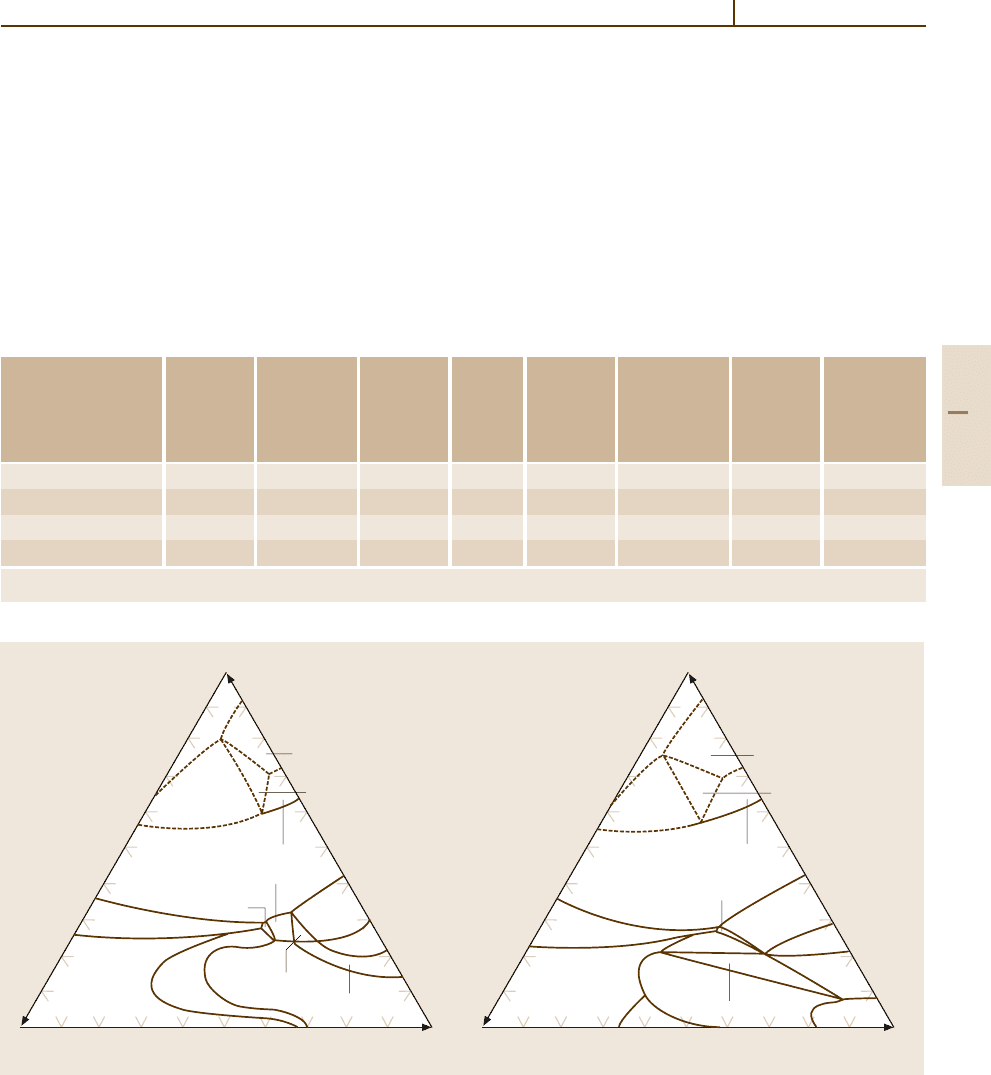
Magnetic Materials 3.3 Hard Magnetic Alloys 797
Commercial materials are characterized by the fact
that they can be quenched from temperatures above the
miscibility gap first, which results in mechanical prop-
erties amenable to forming by conventional processes
such as rolling, stamping, drilling. The final annealing
treatment in the miscibility gap results in the mag-
netically hard state. This is associated with a drastic
decrease in ductility. If the annealing treatment is car-
ried out in a magnetic field, the final product has an
anisotropic behavior. Table 4.3-35 shows the property
range of commercial Fe
−
Cr
−
Co materials.
Table 4.3-35 Commercial Fe
−
Cr
−
Co magnetic materials
Composition Variant Remanence Coercivity Energy Curie Maximum Hardness Commercial
nominal
density temp- application HV designation
a
erature temperature
wt% (T) (kA m
−1
) (kJ m
−3
) (
◦
C) (
◦
C)
Fe
−
27Cr
−
11Co
−
Mo isotropic 0.85–0.95 36–42 13 640 480 480 12/160
Fe
−
28Cr
−
16Co
−
Mo isotropic 0.80–0.90 39–45 15 640 480 480 16/160
Fe
−
27Cr
−
11Co
−
Mo anisotropic 1.15–1.25 47–55 35 640 480 480 12/500
Fe
−
28Cr
−
16Co
−
Mo anisotropic 1.10–1.20 53–61 37 640 480 480 16/550
a
Designation of CROVAC
®
by Vacuumschmelze, Hanau, Germany
10
20
30 40 50 60 70 80 90
10 90
8020
30 70
6040
50
60
70
80
90
10
20
30 40 50 60 70 80 90
10 90
8020
30 70
6040
50
60
70
80
90
50
40
30
20
10
50
40
30
20
10
a)
b)
V
Fe Co
x (wt%)Fe
y (wt%) Co
V
Fe Co
x (wt%)Fe z (wt%)V
y (wt%) Co
α
σ
+CoV
3
+CoV
3
α
+CoV
3
α
σ
+
σ
σ
+
α
σ
+
α
1
+
σ
+
α
1
γ
+
σ
γ
+
σ
γ
'
+
σ
γ
'
γ
+
+
α
1
γ
α
1
γ
'
γ
'
γ
+
γ
T = 900°C T = 600°C
α
1
σ
+
α
1
σ
+
σ
+
α
1
γ
'
σ
+CoV
1
σ
+
α
α
+CoV
3
α
+CoV
3
α
σ
+
+
α
1
γ
'
+
σ
γ
'
+
γ
+
γ
'
α
1
+
α
1
γ
α
1
α
'
1
γ
γ
+
γ
'
γ
'
z (wt%)V
Fig. 4.3-56a,b Isothermal sections of the Fe
−
Co
−
V phase diagram at 900
◦
C (a) and 600
◦
C (b). α: bcc disordered; α
1
:bcc
ordered (CsCl type); γ : fcc disordered (austenite); γ
: fcc ordered (Au
3
Cu type) [3.56]
4.3.3.2 Fe–Co–V
Magnetic materials based on the Fe
−
Co
−
V alloy
system were the first ductile magnets. The intrinsic
magnetic properties may be found in [3.6] while ex-
tensive magnetic materials data are treated in [3.56].
The optimum magnetic behavior is obtained for al-
loy compositions around Fe–55 wt% Co–10 wt% V. As
the isothermal sections of the Fe
−
Co
−
V phase dia-
gram Fig. 4.3-56a and Fig. 4.3-56b show, this alloy is
mainly in the fcc γ -phase (austenite) state at 900
◦
C,
Part 4 3.3
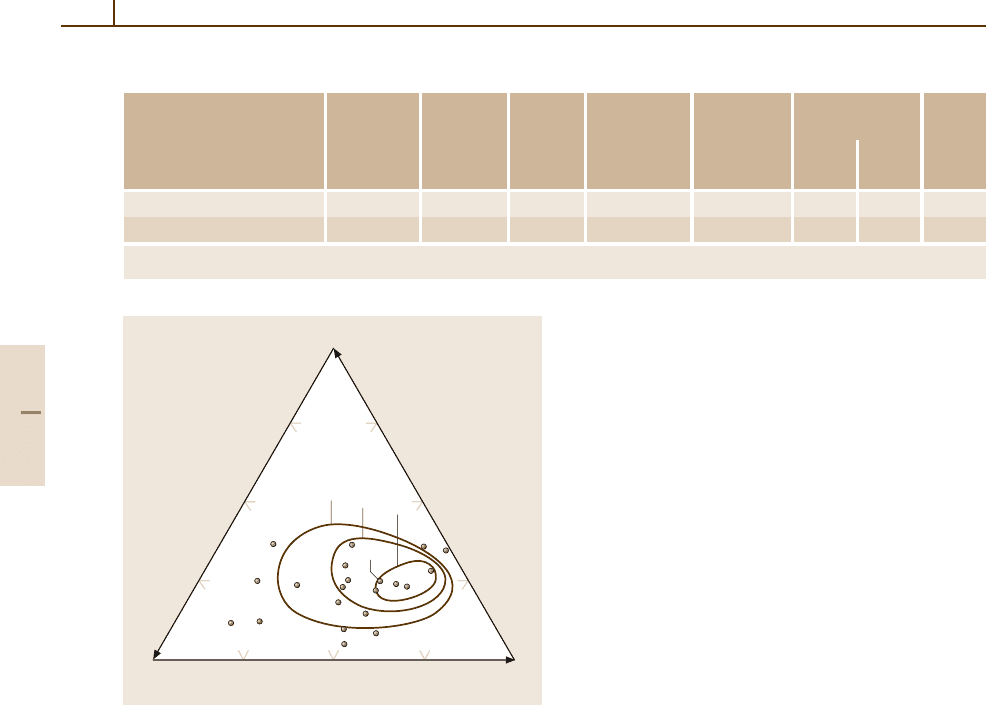
798 Part 4 Functional Materials
Table 4.3-36 Commercial Fe
−
Co
−
V-based magnetic materials
Composition Remanence Coercivity Energy Curie Maximum Hardness (HV) Alloy
nominal
density temperature application code
a
temperature As Heat
(wt%) (T) (kA m
−1
) (kJ m
−3
) (
◦
C) (
◦
C) rolled treated
34Fe
−
52Co
−
13V 0.80–0.90 25–30 12 700 500 480 900 35U
34Fe
−
53Co
−
8.5V
−
3.5Cr 1.00–1.10 30–35 20 700 500 520 950 93
a
Designation of MAGNETOFLEX
®
by Vacuumschmelze, Hanau, Germany
30 40 50 60 70
30
40
30
50
60
70
20
10
0
40
x (wt%)Fe
y (wt%) Co
z (wt%)V
39
27
13
14
36
36
53
85
61
34
119
168
168
169
155
110
146
100
150
18
10
90
106
94
(BH)
max
(10
4
GOe)
Fig. 4.3-57 Contour map of (BH)
max
of Fe
−
Co
−
V alloys
in the optimum annealed state. It is obtained by annealing in
the temperaturerange T
a
= 555–750
◦
C inthe magnetically
preferred direction of the anisotropic sample [3.56]
while it decomposes into the bcc ordered α
1
+γ state
upon annealing at lower temperature such as 600
◦
C. In
combinations of heat treatment with plastic deformation
(also serving to form the product, e.g., wire) an optimum
anisotropic hard magnetic state can be realized.
If quenched from the γ -phase state, the alloy can be
deformed. By a judicious choice of annealing tempera-
tures in the range of 555 to 750
◦
C the maximum energy
product as a function of alloy composition, as shown
in Fig. 4.3-57, may be obtained. This annealing treat-
ment is associated with a drastic increase in hardness,
as indicated in Table 4.3-36, and a concomitant loss in
ductility.
Based on these interrelations of phase equilibria and
thermomechanical treatments as well as by optimization
through further alloyingadditions, commercial magnetic
materials such as those listed with their properties in
Table 4.3-36 have been developed.
4.3.3.3 Fe–Ni–Al–Co, Alnico
The term Alnico refers to two-phase hard magnetic ma-
terials based on the Fe
−
Ni
−
Al system (Fig. 4.3-58).
The intrinsic magnetic properties may be found in [3.6],
while extensive magnetic materials data are treated
in [3.56]. Table 4.3-37 lists some of the magnetic
properties of Alnico type magnets. The magnetically
optimized microstructure consists essentially of elon-
gated ferromagnetic Fe-rich precipitates (α
1
-phase, bcc
disordered) in a non-magnetic matrix of NiAl (α
2
-phase,
bcc ordered, CsCl type). The remanence B
r
is increased
significantly by adding Co, which leads to the forma-
tion of precipitates rich in Fe
−
Co. The coercivity H
c
is
optimized by adding Ti and Cu. The two-phase state
is obtained by a homogenization at about 1300
◦
C,
followed by annealing treatments which lead to de-
composition into structurally coherent phases on the
nanometer scale. The particles are aligned preferentially
along the 100directions of the bcc lattice. This decom-
position microstructure is the essential microstructural
feature. Higher remanence and coercivity prevails in
chill-cast magnets with a columnar microstructure and
100 fiber texture, providing additional magnetocrys-
talline anisotropy. More extensive treatments and data
may be found in [3.10,56, 57].
Part 4 3.3
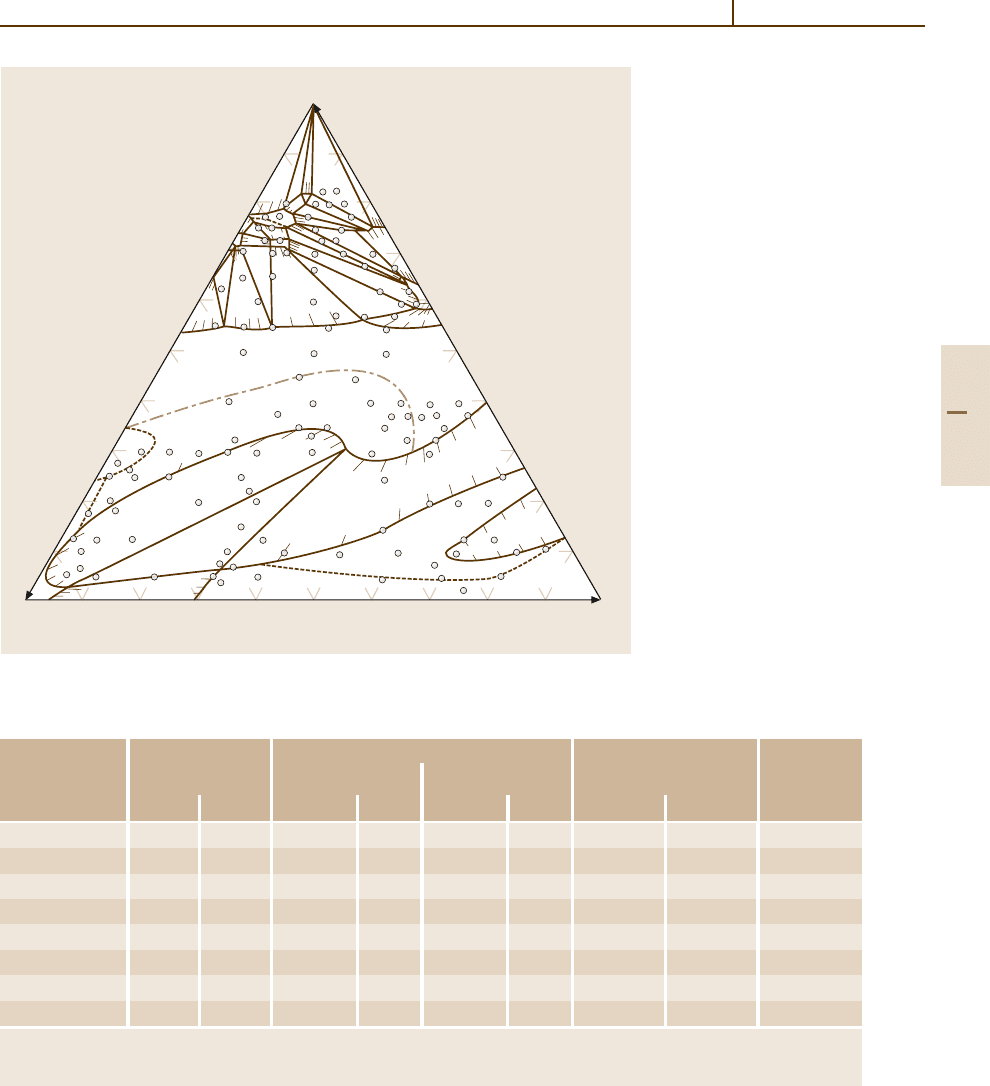
Magnetic Materials 3.3 Hard Magnetic Alloys 799
10
90
20
80
30
70
40
60
50
50
60
40
70
80
90
30
20
10
10 20 30 40 50 60 70 80 90
x (at.%)Fe
y (at.%) Ni
z (at.%) Al
Al
Fe Ni
γ
+
α
2m
α
2n
α
1
α
1
α
2
+
α
1
α
2
+
+
α
2
γ
1
γ
1
γ
γ
γ
'
1
γ
'
1
γ
1
+
Fe
x
Ni
y
Al
z
γ
+
α
1
Fig. 4.3-58 Effective
Fe
x
Ni
y
Al
z
phase diagram
after cooling from the melt at
10 K/h. Broken lines indicate
superlattice phase bound-
aries; the point-dash line
the magnetic phase bound-
ary in the Ni(Al,Fe) phase
field. α
1
: bcc; α
1
:Fe
3
Al-
type superlattice phase; α
2
:
(Fe,Ni)Al-type superlattice
phase; γ : fcc; γ
1
:Ni
3
Al-
type superlattice phase; γ
1
:asγ
1
but with the larger
lattice spacing. The indices
m and n indicate magnetic
and non-magnetic phases,
respectively
Table 4.3-37 Magnetic properties of Alnico type magnets
Designation Remanence Coercivity Energy density Alloy code
b
according B
r B
H
c J
H
c
(BH)
max
to DIN 17410
a
(mT) (G) (kA m
−1
) (Oe) (kAm
−1
) (Oe) (kJm
−3
) (MGOe)
AlNiCo 9/5i 550 5500 54 679 57 716 10.3 1.3 130
AlNiCo 12/6i 650 6500 57 716 60 754 13.5 1.7 160
AlNiCo 19/11i 640 6400 105 1319 115 1433 22.3 2.8 260
AlNiCo 15/6a 750 7500 60 54 62 57 16.7 2.1 190
AlNiCo 28/6a 1100 11 000 64 804 65 817 31.8 4.0 400
AlNiCo 39/12a 880 8800 115 1445 119 1495 43.8 5.5 450
AlNiCo 37/5a 1240 12 400 51 641 51 641 41.4 5.2 500
AlNiCo 39/15a 740 7400 150 1855 160 2011 43.8 5.5 1800
a
i = isotropic; a = anisotropic
b
Commercial designations of Koerzit
®
by WIDIA Magnettechnik
Part 4 3.3
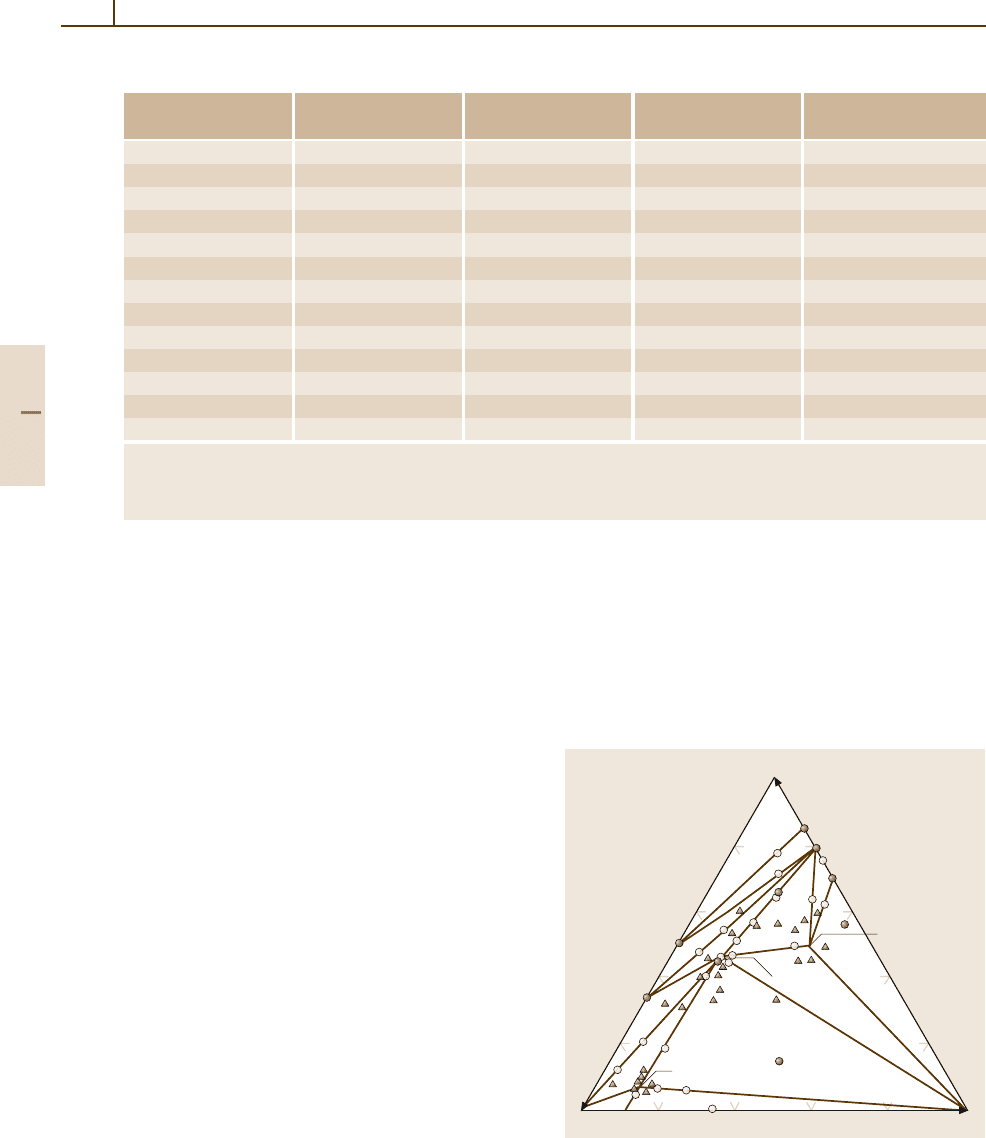
800 Part 4 Functional Materials
Table 4.3-38 Intrinsic properties of Fe
14
RE
2
BatT = 300 K
RE K
1
4πM
s
H
a
= 2K
1
/M
s
T
c
(10
7
erg cm
−3
) (T) (MA m
−1
) (K)
Ce 1.7 1.28 (4) 3.0 430 (6)
Pr 4.5 1.59 (8) 6.3 563 (3)
Nd 4.8(3) 1.68 (9) 5.7 590 (5)
Sm plane 1.55 (10) 618
Gd 1.0 0.94 (2) 2.3 665 (4)
Tb 0.72 (5) 11.1
a
639
Dy 4.1 0.75 (5) 12.6 597 (5)
Ho 0.84 (12) 5.7
a
576
Er plane 1.02 (12) 556 (3)
TM 1.25 (2) 543 (2)
Lu – 2.1
a
538
La – 543
Y 1.1(1) 1.40(5) 2.2 566 (2)
a
Data taken from [3.58]. H
a
value obtained directly by extrapolation of the magnetization curves for the easy and the hard
direction. The average value is given where more than one reference is available; the number in parentheses indicates the
standard deviation in the last figure
4.3.3.4 Fe–Nd–B
The most powerful permanent magnets presently avail-
able consist essentially of the tetragonal Fe
14
Nd
2
B
phase. The intrinsic magnetic properties may be found
in [3.6] while extensive magnetic materials treatments
and data may be found in [3.1, 10, 56]. Two different
production routes are used to prepare dense anisotropic
magnets: conventional powder metallurgy and a rapid
quenching process to produce flake-shaped powder par-
ticles with a nanocrystalline microstructure as a starting
material. The flakes are then processed further into
dense isotropic or anisotropic magnets by means of
a combination of cold pre-forming, hot pressing, and
hot deformation steps.
The Fe
14
RE
2
B phase is formed with all rare earth
(RE) elements with the exception of Eu. Their intrinsic
properties have been investigated extensively. They are
listed in Table 4.3-38. Neodymium shows the highest
permanent magnet potential based on its combination of
high values of K
1
and M
s
.
Conventional Powder Metallurgical Processing
Figure 4.3-59 shows the approximate phase relations of
Fe
−
Nd
−
B at room temperature. According to the phase
diagram of the Fe
−
Nd
−
B system the Fe
14
Nd
2
B phase
forms at 1180
◦
C. In powder metallurgical processing
of the magnets, sintering at 1050
◦
C leads to the forma-
tion of Fe
14
Nd
2
B in equilibrium with a Nd-rich liquid
and with the Fe
4
NdB
4
boride phase. The liquid phase
solidifies below the ternary eutectic at 630
◦
C. The re-
sulting non-magnetic Nd-rich solid phase spreads along
B
Fe Nd
Nd
3
Fe
12
Fe
2
B
FeB
NdB
2
NdB
4
Nd
3
B
5
NdFe
2
B
2
Nd
2
FeB
3
Nd
2
Fe
14
B
Fig. 4.3-59 Approximate phase relations of Fe
−
Nd
−
Bat
room temperature
Part 4 3.3
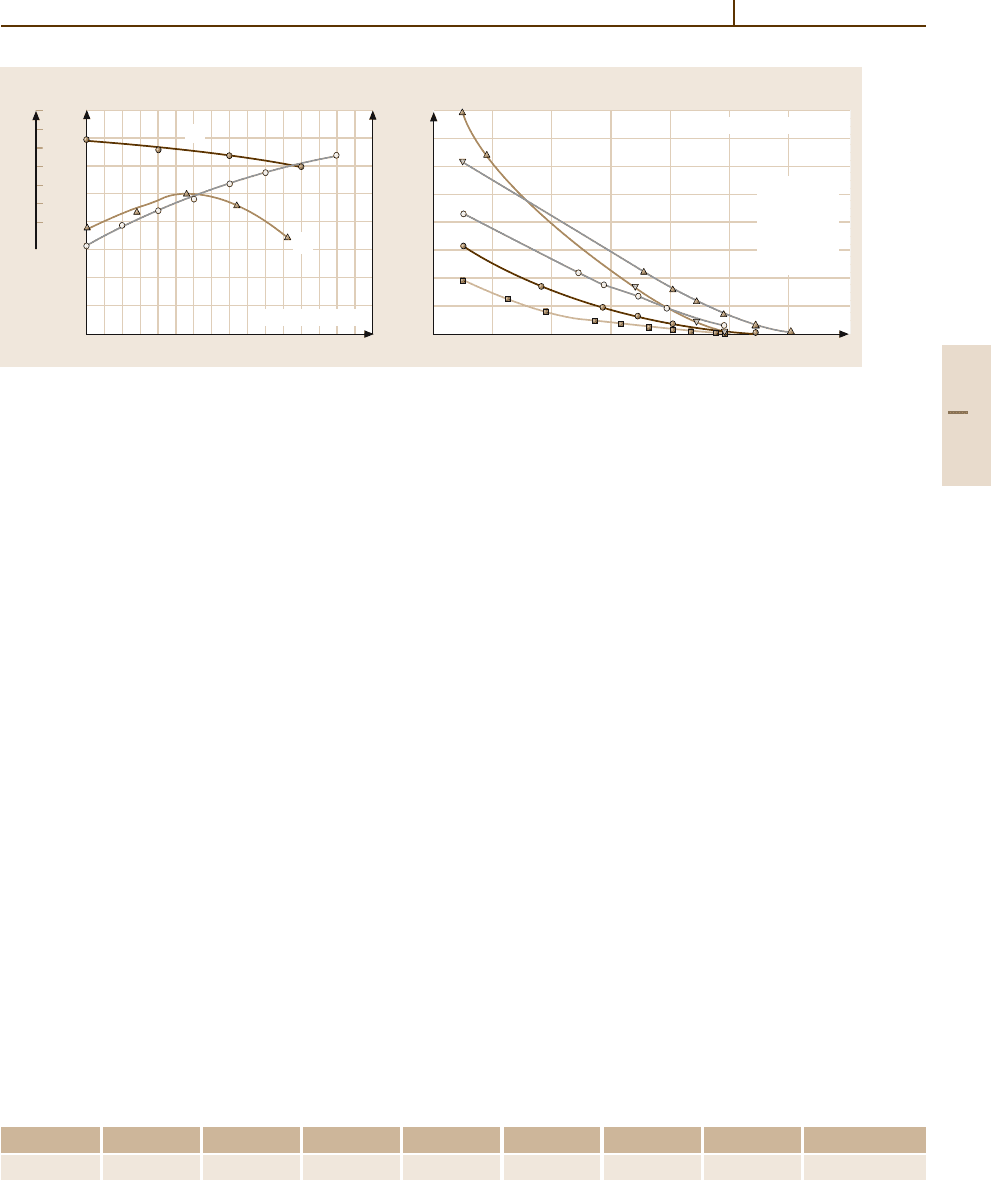
Magnetic Materials 3.3 Hard Magnetic Alloys 801
80
60
40
800
600
400
200
0
02468
4
3
2
1
0
0 100 200 300
2
1.8
1.6
1.4
1.2
H
a
(kOe)
a)
T
c
(°C)
x
H
a
T
c
M
s
T(°C)
H
c
,
j
(MA m
–1
)
5
4
3
2
1
Fe
(14–x)
Co
x
Nd
2
B
Fe77 (Nd
1–x
Dy
x
)15B8
Curve x
1
2
3
4
5
0
0.1
0.2
0.33
0.47
b)
M
s
(T)
Fig. 4.3-60a,b Influence of substitutional elements on Fe
14
Nd
2
B type magnets. (a) Influence of the Co content on
the intrinsic properties at room temperature. Data for the magnetization M
s
, for the anisotropy field H
a
, and for the
Curie temperature T
c
. (b) Influence of the Dy content on the temperature dependence of the coercivity
J
H
c
of sintered
magnets. There is an approximately linear increase of
J
H
c
at room temperature. The temperature dependence increases
with increasing Dy content
the grain boundaries and provides the magnetic decou-
pling of the Fe
14
Nd
2
B grains, thus providing the basic
coercivity of the sintered magnet.
Additions of Dy and Al are increasing the coerciv-
ity. Dysprosium enters the RE sites in the Fe
14
Nd
2
B
structure, increasing the magnetocrystalline anisotropy
but decreasing the magnetic remanence B
r
. At compo-
sitions of > 2at.% Al, the anisotropy field H
a
decreases
linearly at a rate of 0.13 MA m
−1
per at.% Al. Never-
theless the coercivity increases significantly due to an
optimization of the microstructure: Al is enriched in the
Nd grain boundary phase which is spreading more uni-
formly around the magnetic grains, thus leading to better
decoupling of exchange interactions. This is a basic
condition for the increase in coercivity.
As indicated by Fig. 4.3-60a, Co addition leads to
a strong increase of the Curie temperature. However, the
anisotropy field H
a
is reduced by Co, and the decrease of
the coercive field is even larger than expected from this
decrease in H
a
. On the other hand, there is only a small
increase in the magnetic saturation with a maximum at
20 at.% Fe substituted by Co. Accordingly the alloying
is limited to 20 at.%Co.
The vulnerability of RE compounds to corrosion
is a problem. The corrosion behavior of Fe
−
Nd
−
B
Table 4.3-39 Elements used for manufacturing Fe
−
Nd
−
B magnets
Element Fe Nd B Dy Co Al Ga Nb, V
wt% balance 15–33 0.8–1 0–15 0–15 0.5–2 0–2 0–4
magnets has been improved by adding elements which
influence the electrochemical properties of the Nd-rich
grain boundary phase. Additions of small amounts of
more noble elements such as Cu, Co, Ga, Nb, and V
result in the formation of compounds which replace
the highly corrosive Nd-rich phase. Table 4.3-39 lists
some of the elements used for manufacturing Fe
−
Nd
−
B
magnets.
A multitude of grades of Fe
−
Nd
−
B magnets is pro-
duced by varying chemical composition and processing,
such as the press technique applied in order to satisfy the
different specifications required for the different fields
of application. A maximum remanence is needed, for
instance, for disc drive systems in personal computers
and for background field magnets in magnetic resonance
imaging systems. On the other hand, straight line demag-
netization curves up to operating temperatures of 150
◦
C
are specified for application in highly dynamic motors.
This requires very high coercive fields at room tempera-
ture. Magnetic remanence values of B
r
> 1.4 T as well
as
J
H
c
values of > 2500 kA/m can be achieved. How-
ever, high B
r
values are attainable only with lowering
the
J
H
c
value and the operating temperature, and vice
versa. Possible combinations of B
r
and
J
H
c
for a given
manufacturing process (pressing technique), can be rep-
Part 4 3.3
